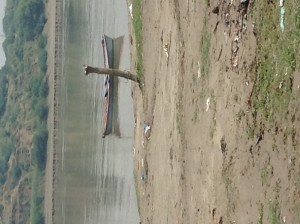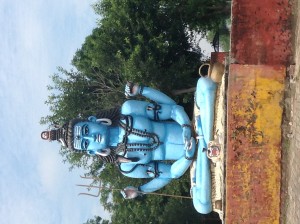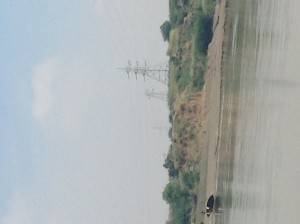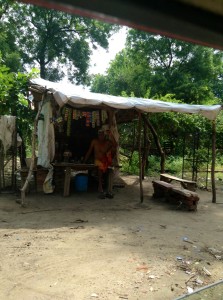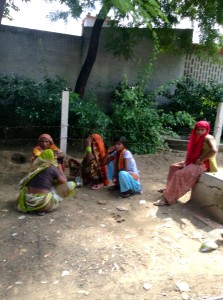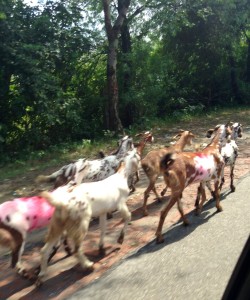My Agra host lives in a very nice neighborhood on the western side of Agra. Usually, when we get to the main road, we turn right. This takes us into the town and its traffic. The other day we turned left. In moments we were in a countryside of wheat fields, cattle, and goats, driving down a shaded road to the shore of the Yamuna River. Modern life slipped away as we encountered people doing the same activities that have gone on for thousands of years — only now there is cell phone coverage.
The road leads to the shore of the Yamuna River.
The Yamuna River winds past the Taj Mahal. It would be a short distance and lovely idyll by boat, instead of traffic snarls all the way. When I first arrived in Agra, it was Ganeshchaturthi – a festival held for Lord Ganesha. At the end of the festival, worshipers make images of Ganesha which are taken for immersion in the closest body of water. In this case, the Yamuna river. Environmentalists have become concerned. At one time, the images were made of mud, which returned to that state after immersion. Now believers use various materials, including papier-mâché, which add to the general pollution of the water.
I don’t think the environmental supporters will have much success in this campaign. Each group of worshippers wants to honor Ganesha with a glorious image, which is taken through town on its way to the river. There is music, dancing, a colorful “face paint.” The immersion marks Ganesha’s rebirth.
The road ends by the crematorium presided over by Shiva – the god of transformation. He is depicted as a benevolent figure. The Goddess Ganga pears out from the topknot in Shiva’s hair.
It’s curious to see modern and traditional life close together. Herders urge their cattle out of the river. Above them, electric grids stride across the water.
Work done, men relax for conversation.
Women share news of the day
Goats go on their merry way.
Some goats might be considered merrier than others. When I took this picture, I thought it was another shot of the herd. Only later did I realize what was really going on. That’s the thing about India. It’s impossible to truly see what is in front of your eyes. Only later does a visitor have a fuller understanding.

Sandra Wagner-Wright holds the doctoral degree in history and taught women’s and global history at the University of Hawai`i. Sandra travels for her research, most recently to Salem, Massachusetts, the setting of her new Salem Stories series. She also enjoys traveling for new experiences. Recent trips include Antarctica and a river cruise on the Rhine from Amsterdam to Basel.
Sandra particularly likes writing about strong women who make a difference. She lives in Hilo, Hawai`i with her family and writes a blog relating to history, travel, and the idiosyncrasies of life.

